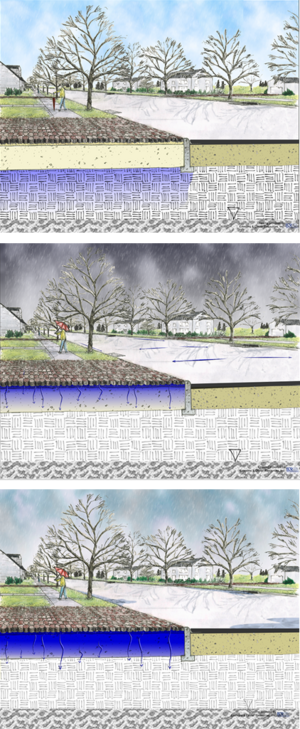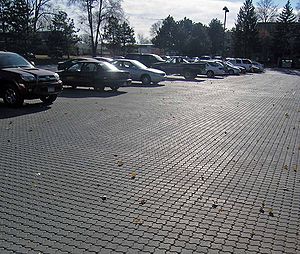
Overview for permeable pavement
Permeable pavements allow stormwater runoff to filter through surface voids into an underlying stone reservoir where it is temporarily stored and/or infiltrated. The most commonly used permeable pavement surfaces are pervious concrete, porous asphalt, and permeable interlocking concrete pavers (PICP). Permeable pavements have been used for areas with light traffic at commercial and residential sites to replace traditionally impervious surfaces such as low-speed roads, parking lots, driveways, sidewalks, plazas, and patios. While permeable pavements can withstand truck loads, permeable pavement has not been proven in areas exposed to high repetitions of trucks or in high speed areas because its’ structural performance and surface stability have not yet been consistently demonstrated in such applications.
While the designs vary, all permeable pavements have a similar structure, consisting of a surface pavement layer, an underlying stone aggregate reservoir layer, optional underdrains, and geotextile over uncompacted soil subgrade. From a hydrologic perspective, permeable pavement is typically designed to manage rainfall landing directly on the permeable pavement surface area. Permeable pavement surface areas may accept runoff contributed by adjacent impervious areas such as driving lanes or rooftops. Runoff from adjacent vegetated areas must be stabilized and not generating sediment as its transport accelerates permeable pavement surface clogging. Additionally, the capacity of the underlying reservoir layer limits the contributing drainage area.

Contents
Benefits and limitations
- Benefits: Permeable pavements allow conversion and/or design of typical impervious areas (i.e. parking lots) to pervious areas that infiltrate stormwater runoff. When compared to typical impervious areas, properly designed and maintained permeable pavements can reduce the runoff quantity, reduce total suspended solids (TSS) and total phosphorus (TP) loads into receiving water bodies, and reduce runoff temperatures. In addition, permeable pavements can reduce nitrogen, metals and process oils. Permeable pavements are well suited for high density urban areas with limited space ( highly urban and ultra-urban environments) for other BMPs such as wet ponds, swales or bioretention systems.
- Limitations: As with all BMP’s, permeable pavement has limitations that need to be considered before design and construction. Limitations are discussed in detail in the permeable pavement design section.
Pretreatment considerations
Pretreatment that removes sediment from runoff draining onto permeable pavement from impervious surfaces is desirable since sediment can clog permeable pavements. For that reason, pretreatment areas should emit practically no sediment onto the permeable pavement surface. Locating such areas next to impervious surfaces upslope from the permeable pavement may not be possible on some sites. Permeable pavement itself can be considered a pretreatment device and included in a stormwater treatment train if underdrains are utilized within the storage reservoir. The underdrains will typically be routed to a bioretention area.
Permit applicability
Permeable pavements can be utilized to assist in meeting stormwater requirements for volume, total suspended solids, and total phosphorus. The section on credits provides guidance on the implementation of permeable pavements that may be utilized to meet various runoff volume and pollutant runoff reduction goals ( credits).
Retrofit suitability
In most cases, existing impervious surfaces can be replaced with permeable pavements to achieve improved runoff conditions. Retrofit requires the removal of the old pavement and subgrade and the installation of the underlying reservoir layer and the permeable pavement. For the greatest water quality credits, avoid compaction of subgrade soils. If this is not possible, compacted subgrade soils should be removed or loosened to achieve the maximum infiltration rate possible.
Cold climate suitability
Favorable permeable pavement performance has been documented in cold climates. Air in the aggregate base acts as an insulating layer and the higher latent heat associated with higher soil moisture delays the formation of a frost layer while maintaining permeability and this condition also reduces frost depths when frozen. Winter sanding should be avoided when possible and if used, removed by vacuuming the following spring. Permeable pavements require significantly less use of, or in some cases, no deicing chemicals and sand to maintain a safe walking or driving surface. Other climate considerations include high wind erosion. Dramatic reductions in life span of the infiltration properties of the pavement may occur in these areas due to particulate clogging and this may require additional surface vacuum cleaning.
Special receiving waters suitability
Many of the same design considerations and limitations apply to permeable pavement as to other infiltration practices.
- Infiltration of runoff from stormwater hotspots (e.g., gas stations, chemical storage areas, etc.) should be carefully considered and in many cases avoided.
- Special consideration also needs to be taken near Wellhead Protection Areas and basement foundations.
- Some designs may require consideration of storms in excess of the infiltration capabilities of the pavement. For these situations the design should ensure the excess runoff does not negatively impact special receiving waters (e.g.,trout streams) through the implementation of additional BMPs.
The table below provides guidance regarding the use of permeable pavement practices in areas upstream of special receiving waters. Note that the suitability of a practice depends on whether the practice has an underdrain (i.e. filtration vs. infiltration practice).
Infiltration and filtration bmp1 design restrictions for special waters and watersheds. See also Sensitive waters and other receiving waters.
Link to this table
| BMP Group | receiving water | ||||
|---|---|---|---|---|---|
| A Lakes | B Trout Waters | C Drinking Water2 | D Wetlands | E Impaired Waters | |
| Infiltration | RECOMMENDED | RECOMMENDED | NOT RECOMMENDED if potential stormwater pollution sources evident | RECOMMENDED | RECOMMENDED unless target TMDL pollutant is a soluble nutrient or chloride |
| Filtration | Some variations NOT RECOMMENDED due to poor phosphorus removal, combined with other treatments | RECOMMENDED | RECOMMENDED | ACCEPTABLE | RECOMMENDED for non-nutrient impairments |
1Filtration practices include green roofs, bmps with an underdrain, or other practices that do not infiltrate water and rely primarily on filtration for treatment.
2 Applies to groundwater drinking water source areas only; use the lakes category to define BMP design restrictions for surface water drinking supplies
Water quality
In general, permeable pavement provides removal of TSS and other pollutants through processes similar to other filtration and infiltration BMPs. However, permeable pavements are not suggested for areas that may receive high loading rates of TSS due to their propensity for surface clogging. The expected annual volume and pollutant reductions for designs without an underdrain are a function of the underlying reservoir storage volume. The greater the storage volume, the greater the annual volume and pollutant reductions.
For designs with underdrains, reductions are typically lower depending on the drain outflow location that determines the volume of water removed by the underdrains before infiltration. Of the water intercepted and draining through the underdrain, 45 percent (with upper and lower 90 percent confidence bounds of 65 percent and 24 percent, respectively) of the total phosphorus and 74 percent (with upper and lower 90 percent confidence bounds of 93 percent and 33 percent, respectively) of total suspended solids removal can be expected. These event mean averages and ranges are derived from a literature review on research on permeable pavements. The literature includes 19 studies on pollutant reductions and 10 studies on volume reductions. (See the section on credits for more information on pollutant reduction credits and their relationship to the MIDS credit calculator).
Water quantity
The primary advantage of permeable pavements is providing volume reduction by reducing runoff from a site and/or providing attenuation from outflows. The volume of water that will be reduced during a given rainfall event will be equivalent to the volume available for storage below the pavement or underdrain (if an underdrain is present). More discussion on this item is available in the section on credits.
Related articles
- Overview for permeable pavement
- Types of permeable pavement
- Design criteria for permeable pavement
- Construction specifications for permeable pavement
- Assessing the performance of permeable pavement
- Operation and maintenance of permeable pavement
- Calculating credits for permeable pavement
- Case studies for permeable pavement
- Green Infrastructure benefits of permeable pavement
- Summary of permit requirements for infiltration
- Permeable pavement photo gallery
- Additional considerations for permeable pavement
- Links for permeable pavement
- References for permeable pavement
- Fact sheets for permeable pavement
- Requirements, recommendations and information for using permeable pavement BMPs in the MIDS calculator
This page was last edited on 27 December 2022, at 19:28.


